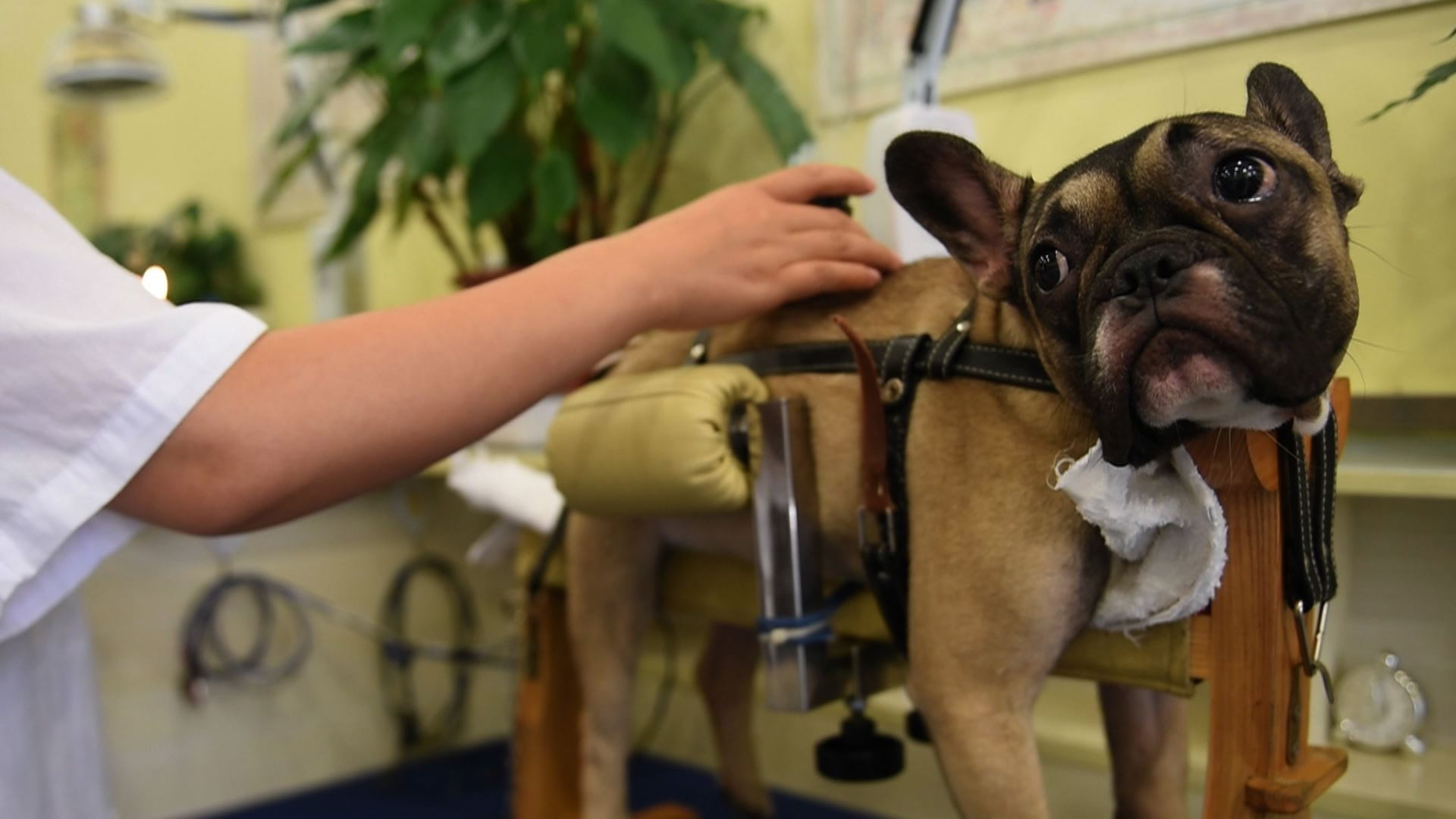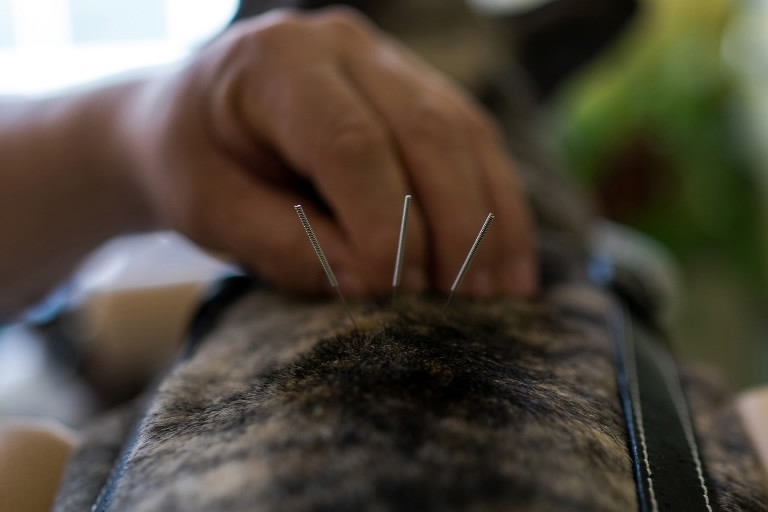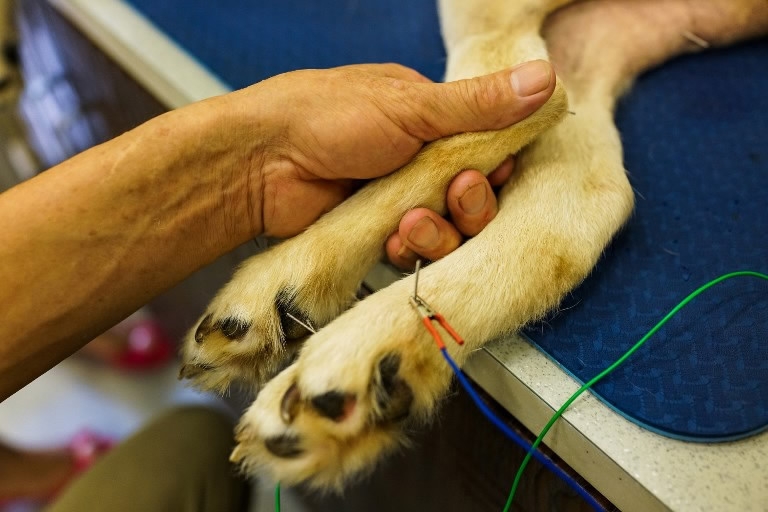
Culture
22:12, 28-Aug-2017
Acupuncture an alternative for pets with spinal injuries
CGTN

At the Shanghai clinic of traditional Chinese medicine (TCM), practitioner Jin Rishan treats pets suffering from severe spinal or nervous-system injuries with acupuncture.
Looking like a furry brown pincushion, eight-month-old French bulldog "Dan Jiao" whimpers nervously as he waits for the end of a Chinese acupuncture session aimed at curing partial paralysis caused by a puppyhood injury.
"Dan Jiao" ("Egg Dumpling"), would obviously rather be chewing on a bone somewhere than sitting strapped against his will into a harness that resembles a medieval torture device, pricked by several long needles hooked up to a mild electric current.
"We're getting more and more customers," said Jin, 53, whose Shanghai TCM Neurology and Acupuncture Animal Health Center is operating at full capacity of around 20 patients per day, and growing.
Many dogs suffer from tough-to-treat back injuries or spinal deterioration that can render them unable to walk. A range of breeds including Bulldogs, German Shepherds, Collies, Basset Hounds and Shi Tzus are particularly prone.
"Seventy percent of the animals here suffer from spinal disc herniation, leading to paralysis of the hind legs or all four legs," Jin said, adding that acupuncture is "more effective" than modern medicine.
"Western medical practices can't do much," he said.

A partially paralyzed dog receives acupuncture treatment with needles known as meridians at the Shanghai Traditional Chinese Medicine (TCM) Neurology and Acupuncture Animal Health Centre in Shanghai on August 26./AFP Photo
A partially paralyzed dog receives acupuncture treatment with needles known as meridians at the Shanghai Traditional Chinese Medicine (TCM) Neurology and Acupuncture Animal Health Centre in Shanghai on August 26./AFP Photo
Signs of hope
It appears to be working for "Dan Jiao," who was completely paralyzed when his owner Michael Xu first brought him in for treatment after a fall that broke his back.
"After three days of acupuncture, he was slowly able to crawl on his front paws. By the seventh day, he was able to limp on all four legs."
On Friday, patients ranging from a gangly black Labrador to a tiny teacup poodle were carried in by their owners or carted in baby prams.
They were eventually strapped into harnesses before the thin acupuncture needles were inserted into their problem spots.

Dong Jinling holds his partially paralyzed dog Lulu as it receives acupuncture treatment at the Shanghai Traditional Chinese Medicine (TCM) Neurology and Acupuncture Animal Health Center in Shanghai on August 26. /AFP Photo
Dong Jinling holds his partially paralyzed dog Lulu as it receives acupuncture treatment at the Shanghai Traditional Chinese Medicine (TCM) Neurology and Acupuncture Animal Health Center in Shanghai on August 26. /AFP Photo
Others sniffed nervously as smoking moxibustion cups -- a form of heat therapy that involves burning aromatic plants -- were applied to their hides.
But the place had not completely gone to the dogs. The day's sole feline patient looked particularly put out, being completely strapped down to prevent it squirming around.
Wang Ping, the owner of "Mei Mei" ("Little Sister"), has fresh hope of getting the five-month-old teacup poodle back on her tiny feet after a paralyzing neck injury suffered three months ago.
"I went to traditional clinics with "Mei Mei" but the vets said she was too small for surgery," Wang said.
Doctors initially recommended euthanasia before referring Wang to Jin's clinic.
"So I came over and she's much better, at least she can lift her head and crawl a bit now."
Jin's practice is based on the feeling that a pet is like a human member of the family, entitled to the same loving care.
"In the past, Chinese people had a very weak notion of what a pet was. But now more and more families treat pets as a companion or family member. So they care so much about their pets, it is not like in the past."
1063km
Source(s): AFP

SITEMAP
Copyright © 2018 CGTN. Beijing ICP prepared NO.16065310-3
Copyright © 2018 CGTN. Beijing ICP prepared NO.16065310-3